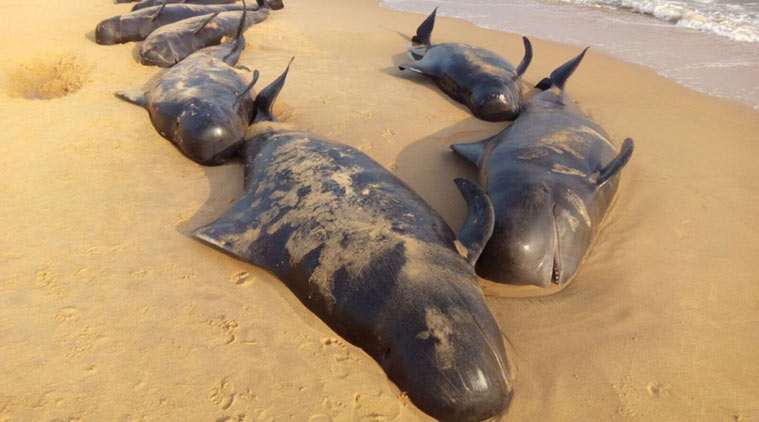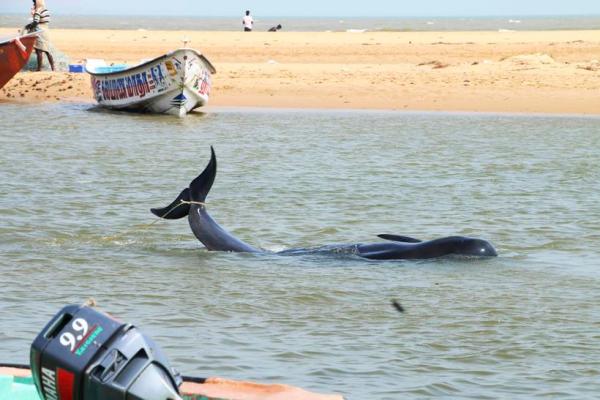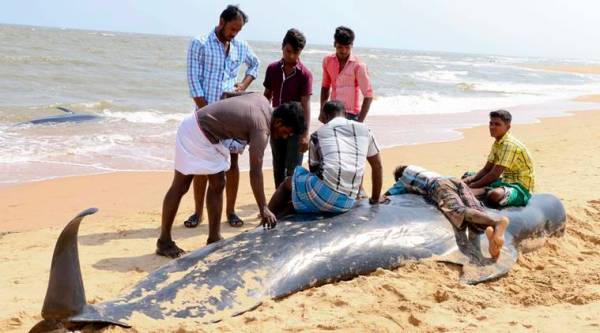More than 100 short-finned pilot whales were stranded along a 15-km stretch of Manapad beach south of the port city of Thoothukudi (Tuticorin) in Tamil Nadu this week, and at least 60 died. How did the giant creatures show up in these shallow waters? How do whales find their way around the oceans — and why do they get beached?

Think of a hippo. Add a tail fin, flippers and the ability to stay under water for much, much longer. Take away those molars and the ability to live on land. If that’s difficult to imagine, it’s possibly because their ancestors parted ways some 50 million years ago.
Whales are fully aquatic marine mammals. They live in water, but must surface to breathe through blowholes on their heads. That is why they can’t sleep like other mammals must. Studies on captive whales show they let only one side of their brain sleep at a time, while the other works to keep the animal swimming and surfacing for air.
The other challenge is to deliver babies under water. Whales give birth with the foetus positioned for tail-first delivery, so it does not drown. Suckling the baby is to jet-spray it.
Like dolphins, whales are remarkably intelligent, and live cultural lives. They play, learn, teach, cooperate, grieve, and are known for complex vocalisation. The Cultural Lives of Whales and Dolphins, by Hal Whitehead and Luke Rendell, offers a fascinating account.
While some whales have baleen, a filter-feeder system that traps large quantities of plankton and other small prey, others have teeth. Generally, baleen whales are bigger and slower than toothed whales.

How do whales move?
Toothed whales use echolocation, like bats. They throw sound waves through the water — and when the waves hit a prey, vessel or barrier, the whales’ brains process the echo to determine the location, size, shape and texture of the object.
Story continues below this ad
Baleen whales migrate over huge distances without deviating off-course for more than a single degree. Researchers from the University of Canterbury who tracked 16 humpback whales over a length of time concluded no established models of directional orientation — magnetic or solar — could explain their extreme navigational precision.

So, what then gets whales beached?
Nobody knows for sure, even though whale stranding is neither an uncommon nor a recent phenomenon. While dead individuals would naturally wash up ashore, mass beaching has baffled humans since at least 300 BC. “It is not known why they sometimes run aground on the seashore,” noted Aristotle. “It is asserted that this happens when the fancy takes them and without any apparent reason.” Centuries later, the Romans thought stranding was a whale’s punishment for offending Neptune, the god of the seas.
 People look at one among the dozens of whales that have washed ashore on the Bay of Bengal coast’s Manapad beach in Tuticorin district, Tamil Nadu state, India, Tuesday, Jan.12, 2016. (Source: AP)
People look at one among the dozens of whales that have washed ashore on the Bay of Bengal coast’s Manapad beach in Tuticorin district, Tamil Nadu state, India, Tuesday, Jan.12, 2016. (Source: AP)
Okay, so what is it that we do know?
Toothed, rather than Baleen whales, are usually stranded. Whales living in large social groups — such as the pilot whales that beached in Tuticorin — are more susceptible. An entire pod can follow a disoriented leader into shallow waters and beach themselves.
Story continues below this ad
Following prey-rich currents might draw whales towards land, or they might end up panicking at the presence of a mega predator such as a killer whale. Gently-sloping shorelines can deceive whales dependent on echolocation for navigation, scientists say.
There’s also climate change or unnatural weather phenomena. In one recorded event, after a strong El Niño in 1982-83, a resident population of short-finned pilot whales apparently disappeared from areas along southern California.
What about the impact of SONAR?
Active SONAR (sound navigation and ranging) — low frequency sound released under water to detect marine vehicles — is the human version of the same technology that whales use to find their way. The immense pressure of manmade SONAR waves can cause internal bleeding in the ear and brain tissues, killing or disorienting whales. Some scientists also argue that whales may interpret SONAR as an approaching predator, triggering panic and subsequent beaching.
Interestingly, the last mass whale stranding in Tuticorin occurred not long after the 1971 war that might have necessitated intense and prolonged scanning of these waters. Sources at Central Marine Fisheries Research Institute (CMFRI) said “the SONAR aspect was probably not covered” in the studies that followed that 1973 stranding of 147 whales.
What about the whales this week?
Story continues below this ad
These were short-finned pilot whales, inhabitants of deep, warm waters in the Indian, Pacific and Atlantic Oceans, and yet known for frequent stranding. Their pods of up to 50 animals form ranks that can stretch over a kilometre. This may explain how dozens of animals beach themselves across several kilometres, but it is not clear why they approach shallow waters in the first place. In India, the first recorded beaching of short-finned pilot whales was in 1852 near Kolkata.
[related-post]
Is the Tuticorin shoreline to blame?
It is difficult to say. Repeated beaching in one area may suggest a flat slope or currents unique to the shoreline. Dutch scientist Dudok van Heel found in 1962 that gently sloping beaches would not supply a coherent reflection to sonar.
In the late 1990s, researchers from the University of Western Australia concluded that a gently sloping beach — like the one off Ocean Beach town in Western Australia, where the depth rolled from zero to 20 m over 3 km out at sea — posed major problems for echo-navigation. The Manapad beach is even flatter — from zero to 5-17 m over 3 km. “The Adam’s Bridge area is shallow and the slope is flat. But we cannot comment at this stage if that is a factor behind whale stranding. We need further studies,” Dr P P Manoj Kumar, scientist-in-charge at CMFRI’s Tuticorin centre, said.

 Whales living in large social groups — such as the pilot whales that beached on Monday and Tuesday — are more susceptible to mass beaching. (Express Photo)
Whales living in large social groups — such as the pilot whales that beached on Monday and Tuesday — are more susceptible to mass beaching. (Express Photo)


 People look at one among the dozens of whales that have washed ashore on the Bay of Bengal coast’s Manapad beach in Tuticorin district, Tamil Nadu state, India, Tuesday, Jan.12, 2016. (Source: AP)
People look at one among the dozens of whales that have washed ashore on the Bay of Bengal coast’s Manapad beach in Tuticorin district, Tamil Nadu state, India, Tuesday, Jan.12, 2016. (Source: AP)




































